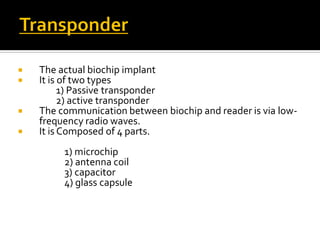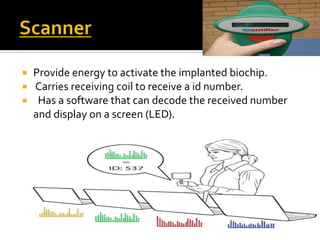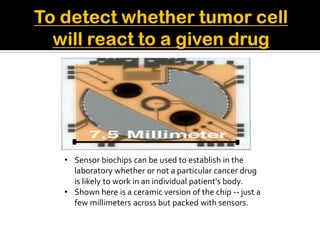Biochips: Biosensor
- 1. Thinking smaller. BIOCHIPS Presented by: JUDITH ANNE JOHNSON-10 ANTRA FULORIA-15 SURBHI-21 DRISHTI SAPRA-32 PRIYANKA KUMARI-35 SHRIYA VERMA-52
- 3. A Biochip is a collection of miniaturized test sites (microarrays) arranged on a solid substrate that permits many tests to be performed at the same time in order to achieve higher throughput and speed. Millions of mathematical calculations Thousands of biological reactions •Based on Electricity •Based on detection of biological analytes Uses Low Frequency Radio waves MICROCHIP BIOCHIP
- 4. Size: 2 to 12 inches, Smaller than an uncooked rice grain. Small volume of sample required Parallelism: Many tests can be performed at the same time Fast speed Lower cost Higher sensitivity
- 5. Use: Therapeutic and diagnostic purposes , for identifying gene sequences, detecting air pollutants ,other biochemical reactions etc
- 6. Affymetrix GeneChip The patient donates test tissue that is processed on the array to detect disease-related mutations based on certain diagnostic ‘Markers’
- 7. DNA chip Protein chip Enzyme chip Lab-on-a-chip Implantable chip
- 9. MicroarrayTechnology: A DNA microarray (also commonly known as DNA chip or biochip) is a collection of microscopic DNA spots attached to a solid surface. Used to measure the expression levels of large numbers of genes simultaneously or to genotype multiple regions of a genome. MicrofluidicTechnology: Refers to design of systems in which low volumes of fluids are processed to achieve multiplexing, automation, and design of systems to achieve multiplexing, automation, and high-throughput screening.
- 10. It consist of two parts Transponder Reader or scanner
- 11. The actual biochip implant It is of two types 1) Passive transponder 2) active transponder The communication between biochip and reader is via low- frequency radio waves. It is Composed of 4 parts. 1) microchip 2) antenna coil 3) capacitor 4) glass capsule
- 13. Provide energy to activate the implanted biochip. Carries receiving coil to receive a id number. Has a software that can decode the received number and display on a screen (LED).
- 15. BIOCHIPS are miniature sized (micro – nano dimensions), thus enabling thousands of bio reactions performed simultaneously. Can be introduced into skin (no surgery required). Easy Monitoring and Instantaneous analysis on BIOCHIPS. BIOCHIPS deals with small volumes of samples. BIOCHIPS can be linked with GPS. BIOCHIPS , in present day use , has been extremely useful in early detection of diseases, DNA sequencing technology. BOCHIPS helps in identification of persons uniquely. Low operational costs. Exact diagnosis & negliglible side effects. Automated process , no sample preparation required before tests.
- 16. Initial equipment capital requirement is very high. ( Sophisticated manufacturing ) In earlier Implants , BIOCHIPS were undetected by Metal Detectors due to their micron size. The Immunization Implantation of BIOCHIPS into blood may be dangerous!!!!!!!! Chips once introduced into body cant be removed. Thy raise the issues of PERSONAL PRIVACY (if used in case of humans) The chip could be broken in the body & turn out fatal. As the BIOCHIPS implanted in the body skin is in contact of DNA ,it may lead to cellular mutation andCANCER!!! They cant be fabricated at higher density and mass.
- 18. BIOCHIPS can be used as Personalized Medicines
- 19. First of all, biochips are defined as devices on which biomolecules such as DNA –---> DNA chips Proteins----> protein chips Sugar chains---->glycochips and Cells –--> cell chips. A large number of target molecules and compounds that specifically interact with biomolecules on chips can be simultaneously analyzed in a large number of samples in parallel.
- 20. Biochips have become indispensable tools to develop new drugs and to improve existing ones.The power of biochips, and in particular DNA arrays, is their ability to experimentally probe gene expression BIOCHIPS identify and prioritise Drug Targets This will lead to growth of protein biochip > DNA biochip as drug targets are mainly proteins Small sized BIOCHIPS tend to be more informative
- 21. The chip can be integrated with a glucose detector. The chip will allow diabetics to easily monitor the level of glucose in the blood. A light-emitting diode (LED) in the biochip starts off the detection process. Glucose is detected because the sugar reduces the amount of light that the fluorescent chemical re- emits.The more the glucose levels, the less light that is detected.
- 23. Oxygen sensors can measure breathing rates, specially in ICUs. The oxygen-sensing chip sends light pulses out into the body. The light is absorbed to varying extents, depending on how much oxygen is being carried in the blood. The rushes of blood pumped by the heart are also detected, so the same chip can be used as a pulse monitor.
- 24. Sensors can be embedded into a biochip which can detect the flow of fluids. A huge variety of hardware circuitry (Sensor) is available in electronics to detect the flow of fluid, embedded into a biochip. It continuously monitors the blood flow rate and when the pressure is in its low or high extremes, it can be immediately informed through the reader to take up remedial measures.
- 26. • Sensor biochips can be used to establish in the laboratory whether or not a particular cancer drug is likely to work in an individual patient's body. • Shown here is a ceramic version of the chip -- just a few millimeters across but packed with sensors.
- 27. • A lab-on-a-chip is a device -- made of glass, for example -- that is just a few millimeters across and has bioelectronic sensors that monitor the vitality of living cells. • The chips sit in small wells, known as microtiter plates, and are covered with a patient's tumour cells. • A robot changes the culture fluid in each well containing a chip at a few minutes time intervals. • The microsensors on the chip record changes in the acid content of the medium and the cells' oxygen consumption. • Photographs of the process are also taken by a microscope fitted underneath the microtiter plate.
- 28. • The robots and microtiter plates are kept in a chamber which provides an environment similar to that of the human body. • After the tumour cells have been able to divide undisturbed for a few hours, the robot applies an anti-cancer substance. • If their metabolic activity declines over the next day or two, the active substance was able to kill the tumour cells and the drug is effective.
- 29. Get affected by hydrodynamic forces Cells undergo migration Put Biochips inside it Mixture of normal cells and cancer cells Collect blood samples from patients
- 30. The bigger cells go up to the cancer cell outlet The smaller cells get pushed down and essentially they get fractionated & separated.
- 31. Once the reader is connected to the internet, satellite and a centralized database is maintained about the (biochip) creatures. Enables tracing of a person/animal anywhere in the world :
- 32. i) Identification of Endangered Wild animals: • Number of species • Detect if animal is sick ii) Identification &Tracking of pets worldwide. iii) Identification of humans • Missing children and natural calamity victims location & identification • In Defense, Soldiers can be identified and even detected if wounded or not.
- 33. Detection of mutations in specific genes Detect the differences in gene expression levels Brain tumor Biochips
- 34. Have been used successfully for the detection of mutations in specific genes as diagnostic "markers" of the onset of a particular disease. The patient donates test tissue that is processed on the array to detect disease- related mutations. The primary example of this approach is the Affymetrix GeneChip.
- 35. The p53 GeneChip is designed to detect single nucleotide polymorphisms of the p53 tumour-suppressor gene. the HIV GeneChip is designed to detect mutations in the HIV-1 protease and also the virus's reverse transcriptase genes. the P450 GeneChip focuses on mutations of key liver enzymes that metabolize drugs. Affymetrix has additional GeneChips in development, including biochips for detecting the breast cancer gene, BRCA1, as well as identifying bacterial pathogens. Other examples of biochips used to detect gene mutations include the HyGnostics modules made by Hyseq.
- 36. A second application for DNA-based biochips is to detect the differences in gene expression levels in cells that are diseased versus those that are healthy. Understanding these differences in gene expression not only serves as a diagnostic tool, but also provides drug makers with unique targets that are present only in diseased cells. For example, during the process of cancer transformation oncogenes and proto-oncogenes are activated, which never occurs in healthy cells. Targeting these genes may lead to new therapeutic approaches.
- 37. Examples of biochips designed for gene expression profile analysis include Affymetrix's standardized GeneChips for a variety of human, murine, and yeast genes, as well as several custom designs for particular strategic collaborators Hyseq's HyX Gene Discovery Modules for genes from tissues of the cardiovascular and central nervous systems, or from tissues exposed to infectious diseases.
- 38. Application of Biochip and Microarray Technology. The BT chip is DNA and oligo DNA microarrays based on differential gene expression in brain tumours.
- 40. In addition to DNA/RNA biochips, protein biochips are being developed in increasing frequencies. Example, development of a quantitative immunoassay for prostate-specific membrane antigen (PSMA). It is based on a protein chip and surface- enhanced laser desorption/ionization mass spectrometry technology1.
- 42. Injected by a hypodermic syringe beneath the skin. Injection is safe and simple. Anesthesia is not required. Usually injected behind the neck.
- 43. The bio-microsystems market is estimated to 620 Millions of Dollars by recapturing the sales of major actors (Affymetrix, Agilent, Ciphergen). DNA chips represent today the major type with more than 83 % of sales. Lab on chip is emerging –mostly with Caliper sales – and represents 10 % of the total. The remainder consists of protein chips(mostly Ciphergen) and other types of DNA arrays.
- 45. A chip implanted some where in human body might serve as a combination of Credit card Driving license Passport Personal identification etc. No longer would it be needed to worry about losing all above thing. Can also widely established in veterinary field.
- 47. Biochips are :- Fast Accurate Miniaturized Advantages upon conventionalAnalyzer Expected to become economically advantageous attributes that make them analogous to computer chip. The future which we imagine of, the CYBER FUTURE will have the BIOCHIP IMPLANTSYSTEM as an integral component to satisfy the ever growing human needs.
- 48. Summary
- 49. Presented By: ShriyaVerma, Priyanka Kumari, Antra Fuloria, Judith Anne Johnson, Drishti Sapra, Surbhi
- 50. http://www.slideshare.net/MrinalSharma7/bi ochip-seminar-ppt-2014 http://www.meddeviceonline.com/doc/googl e-novartis-smart-lens-to-be-ready-for- human-trials-in-0001 http://www.nature.com/nbt/journal/v18/n10s/ full/nbt1000_IT43.html http://pediain.com/seminar/biochip- technology-seminar-report-pdf-ppt.php


















































